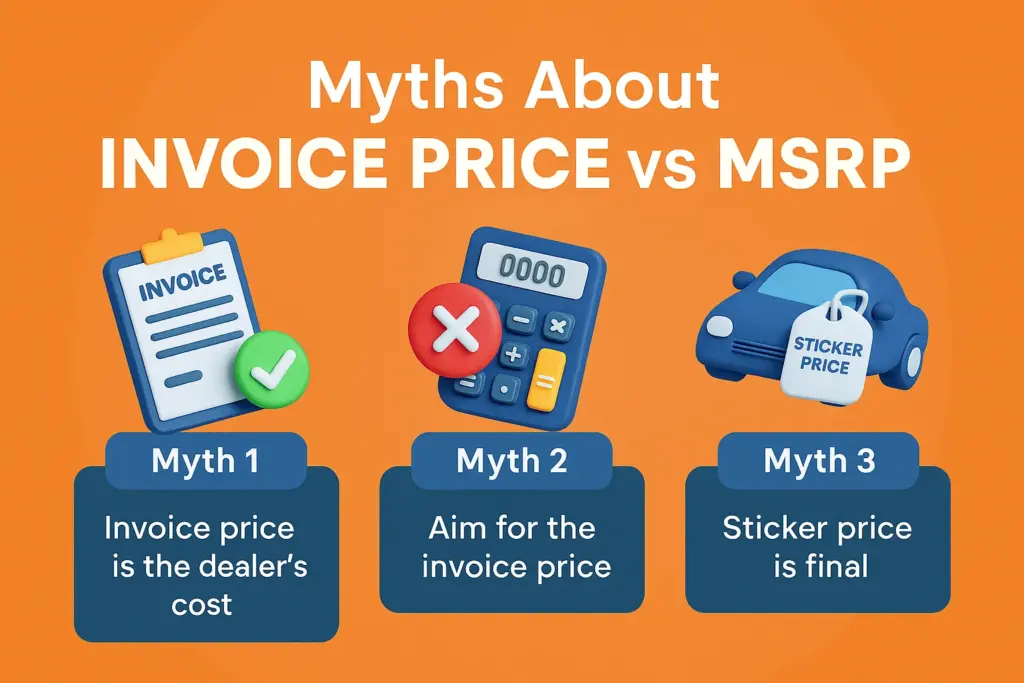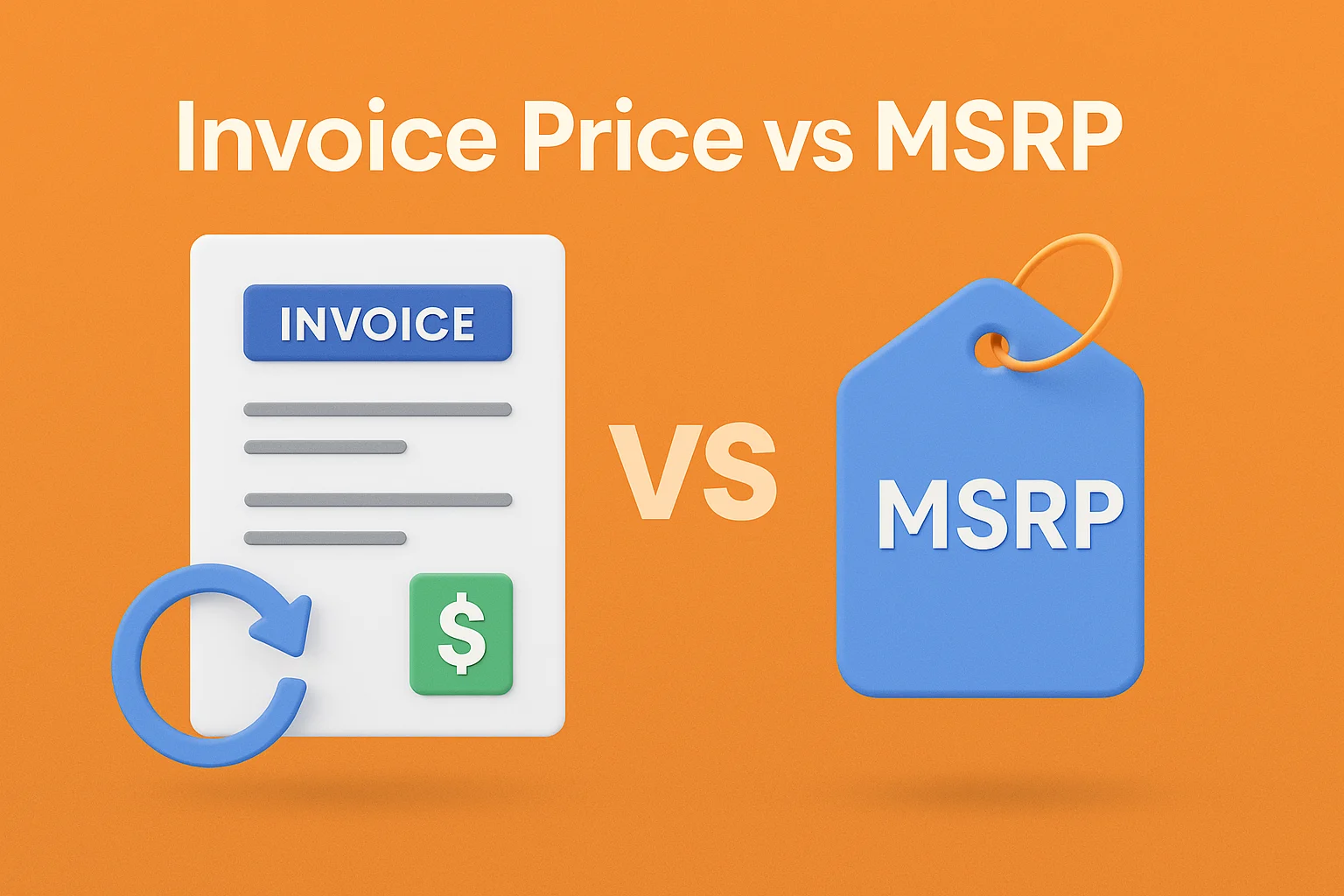Buying a car? Big deal, right? For most of us, it’s one of the biggest money moves we’ll ever make. But here’s the catch — once you’re staring at that shiny ride and its price tag, things can get real fuzzy, real fast. Ever heard of terms like MSRP or invoice price? Yeah, they sound fancy, but what do they really mean? More importantly, how do they mess with what you actually end up paying?
If you’ve ever stepped into a dealership and thought, “Am I getting played here?” — hey, you’re not alone. Lots of folks walk in thinking they’ve got a deal, only to find out later there’s a whole lot going on behind that sticker on the windshield. Between dealer incentives, secret fees, and holdbacks (whatever those are!), the price you see isn’t always the price the dealer paid.
In this guide, we’re breaking down the mystery behind Invoice Price vs MSRP — and trust us, it’s a game-changer. Whether you’re a first-time buyer or a seasoned negotiator, knowing the difference can save you some serious cash. So buckle up — we’re putting you back in the driver’s seat, where your wallet and your choices stay in your hands.
What is MSRP?
MSRP stands for Manufacturer’s Suggested Retail Price. Pretty straightforward — it’s what the carmaker suggests the dealership charge for a vehicle. You’ll usually spot this number proudly displayed on that sticker in the window — hence the nickname “sticker price.”
Now, how do they come up with that number? Automakers look at things like what their competitors are charging, how much it costs to build the car, and what the market’s buzzing about.
But don’t be fooled — the MSRP is just the starting whistle. It kicks off the negotiation, not the finish line. Depending on how hot the car is (or isn’t), how many are available, and what’s happening in the market, the dealer might raise the price… or lower it to make a sale.
Also, baked into the MSRP is a little something for everyone — meaning there’s profit for both the manufacturer and the dealer. For instance, if a sleek new sedan has an MSRP of $30,000, that number isn’t pulled out of thin air. It reflects what the manufacturer thinks the car’s worth and still gives the dealership room to make some dough.
But knowing the MSRP is only half the story. Want to really crack the code on car pricing? Enter the invoice price — and that’s where the real deal-making begins.
What is the Invoice Price?
The invoice price? Oh, that’s just what the dealer hands over to the carmaker to snag the vehicle in the first place. It’s kind of like the dealer’s secret bill—the behind-the-scenes price tag. Think of it as the car’s backstage pass before it rolls onto the showroom floor.
This is the sticker you don’t see. It’s what the dealer gets charged before they ever talk to you about test drives and financing. It’s their starting line, not yours.
Let’s be real—dealers aren’t jumping at the chance to tell you this number. But hey, good news: places like Kelley Blue Book and Edmunds have your back. They’ll help you peek behind the curtain.
Sometimes, the manufacturer sweetens the deal—think bonuses, special rebates, or quiet little kickbacks. That means a dealer might end up paying less than the dealer invoice shows. Sneaky, right?
Example: Say that shiny sedan has an invoice price of $27,000. That’s about what the dealer shells out for it. But wait! The MSRP—the price you see—is $30,000. Boom. There’s already a $3,000 gap. See where you might have room to negotiate?
But it gets more complicated when you realize that invoice price isn’t always what it seems.
Invoice Price vs MSRP: What’s the Difference?
Car Invoice Price vs. MSRP boils down to who benefits from each figure:
- MSRP (Manufacturer’s Suggested Retail Price) is targeted at the final customer. It’s set by automakers and designed to give dealers room for profit.
- Invoice Price, on the other hand, represents the price dealers pay. It’s often lower than the MSRP due to special incentives or discounts.
| Aspect | Invoice Price | MSRP (Manufacturer’s Suggested Retail Price) |
| Definition | The price a retailer (e.g., car dealership) pays to the manufacturer for a product. | The price recommended by the manufacturer for the product to be sold to consumers. |
| Purpose | Represents the cost to the retailer; used for internal pricing and profit calculations. | Serves as a guideline for consumers and retailers for pricing. |
| Visibility | Often not disclosed to consumers; considered internal information. | Publicly displayed and advertised to consumers. |
| Negotiability | Can be negotiated by retailers with manufacturers (e.g., bulk discounts). | Can be negotiated by consumers with retailers (e.g., discounts or promotions). |
| Includes | May include manufacturer discounts, incentives, or rebates for the retailer. | Includes the base price, standard features, and sometimes destination fees. |
| Higher or Lower | Typically lower than MSRP. | Typically higher than Invoice Price. |
| Profit Margin | Retailers aim to sell above this price to make a profit. | Consumers often negotiate below this price to save money. |
| Example (Car) | $25,000 (what the dealer pays the manufacturer). | $30,000 (what the manufacturer suggests the dealer charges the customer). |
When you understand both these numbers, you gain a sense of what a dealer might have paid versus how much they’re asking you to pay. This awareness becomes a powerful tool for price negotiations.
For instance, If a car’s MSRP is $30,000, and its invoice price is $27,000, you know there’s room for negotiation. You can potentially strike a deal closer to the invoice price, saving yourself money.
However, keep in mind that dealerships also need to cover their operational costs (showroom, staff, utilities) and make some profit.
How Do Invoice Price and MSRP Affect Negotiations?
It takes more than just showing up and accepting the sticker price to purchase a car. You have more negotiating power when you understand how invoice price and MSRP relate to one another. Here’s How:

- Recognize Dealer Prices: Manufacturers frequently offer extra incentives or bonuses, reducing their actual cost, even though the invoice price represents the dealer’s wholesale cost. This implies that there may still be opportunity for dealer profit if the MSRP is negotiated lower (and closer to) the invoice price.
- Seek Out Deals: Manufacturers occasionally provide incentives or rebates. For example, they might offer a $1,000 rebate on a specific model, which you might incorporate into your negotiating.
- Time Matters: During specific periods, like year-end sales or when they have to reach quotas, dealers are more inclined to negotiate toward the invoice price.
Instead of depending only on the sticker price, you can make well-informed decisions by knowing the dealership’s starting point (invoice price) and middle ground (MSRP).
Tips for Buyers to Navigate Car Pricing Like a Pro
Buying a car is a significant financial decision. With a little preparation, you can ensure you’re paying a fair price by leveraging invoice price vs MSRP.

1. Do Your Research
Knowledge is power in any negotiation. Tools like Edmunds, Kelley Blue Book, and NADA Guides allow you to look up both the MSRP and invoice price of vehicles you’re interested in.
2. Compare Multiple Dealers
Don’t settle for the first offer. Visit different dealerships, request price quotes, and see how much they’re willing to lower the price.
3. Be Aware of Dealer Incentives
Manufacturers provide dealerships with incentive programs that lower the car cost even further. For example, if a dealer receives a $2,000 factory incentive, they can sell you a car below invoice price and still profit. Understanding this gives you an edge in negotiating.
4. Time Your Purchase
The time of year or month can significantly affect how much you’ll pay. Try shopping:
- At the end of the month when dealers are eager to meet sales quotas.
- During large sales events, such as Memorial Day or Black Friday.
5. Optimize Trade-Ins and Financing Offers
When considering the cost of a new car, factor in your trade-in value and invoice financing terms. A good trade-in offer can lower your overall purchase price.
6. Negotiate Smartly
Start your negotiation below the invoice price, then work upward. Aim for a deal that’s under the MSRP but above the invoice price, keeping both parties satisfied.
Example:
- MSRP = $30,000
- Invoice Price = $27,000
- Negotiation Target = $27,500–$28,000
Also Read About: Purchase Invoice
Myths About Invoice Price vs MSRP
There are many misconceptions about car pricing. Here are a few to keep in mind:

Myth 1) Invoice price is the dealer’s cost: Not always true. Dealers often pay less than the invoice price due to bonuses, incentives, and invoice discounting.
Myth 2) You should always aim for the invoice price: While aiming closer to the invoice price is wise, dealers still need to profit. Be reasonable.
Myth 3) Sticker price is final: MSRP is just a suggestion. Negotiating below it is not only possible but expected.
Final Thoughts
Knowing the difference between invoice price and MSRP? Oh boy, that’s like having a secret map in your back pocket when you’re car shopping. Sounds simple, right? But these two little numbers can seriously change the game. See, the invoice price is kinda like peeking behind the curtain—it shows you what the dealer probably paid for the car. It’s your starting line for haggling. On the flip side, the MSRP (that’s the Manufacturer’s Suggested Retail Price) is the big shiny number on the sticker. That’s where the dealer hopes you’ll start… and maybe even stop.
But here’s the kicker—when you know both, you’re not walking in blind. Nope, you’re walking in with a plan. You can eyeball the wiggle room in price and know exactly where you stand. You might even catch a break and nab that shiny ride for way closer to the invoice price than you thought possible. And hey, if you know about those sneaky dealer incentives—like cash-back bonuses or factory rebates? Jackpot. That’s extra ammo for your deal-making.
Timing’s everything too. Want a tip? Swing by at the end of the month or during a big sales event. Dealers are itching to hit their numbers, and that can work in your favor big time.
In the end, understanding these price points isn’t just about saving some cash—though that’s sweet, too. It’s about walking out of that dealership with your head high, your wallet a little heavier, and your new car feeling like a total win.
Create Invoices Instantly – Free & Easy!
Generate professional invoices in seconds with our Free Online Invoice Generator.
👉 Invoice Generator

Leave a Reply